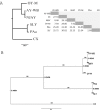Draft genome sequence of the New Jersey aster yellows strain of 'Candidatus Phytoplasma asteris'
- PMID: 29408883
- PMCID: PMC5800598
- DOI: 10.1371/journal.pone.0192379
Draft genome sequence of the New Jersey aster yellows strain of 'Candidatus Phytoplasma asteris'
Abstract
The NJAY (New Jersey aster yellows) strain of 'Candidatus Phytoplasma asteris' is a significant plant pathogen responsible for causing severe lettuce yellows in the U.S. state of New Jersey. A draft genome sequence was prepared for this organism. A total of 177,847 reads were assembled into 75 contigs > 518 bp with a total base value of 652,092 and an overall [G+C] content of 27.1%. A total of 733 protein coding genes were identified. This Whole Genome Shotgun project has been deposited at DDBJ/ENA/GenBank under the accession MAPF00000000. This draft genome was used for genome- and gene-based comparative phylogenetic analyses with other phytoplasmas, including the closely related 'Ca. Phytoplasma asteris' strain, aster yellows witches'- broom (AY-WB). NJAY and AY-WB exhibit approximately 0.5% dissimilarity at the nucleotide level among their shared genomic segments. Evidence indicated that NJAY harbors four plasmids homologous to those known to encode pathogenicity determinants in AY-WB, as well as a chromosome-encoded mobile unit. Apparent NJAY orthologs to the important AY-WB virulence factors, SAP11 and SAP54, were identified. A number of secreted proteins, both membrane-bound and soluble, were encoded, with many bearing similarity to known AY-WB effector molecules and others representing possible secreted proteins that may be novel to the NJAY lineage.
Conflict of interest statement
Figures


Similar articles
-
Characterization of putative membrane protein genes of the 'Candidatus Phytoplasma asteris', chrysanthemum yellows isolate.Can J Microbiol. 2008 May;54(5):341-51. doi: 10.1139/w08-010. Can J Microbiol. 2008. PMID: 18449218
-
'Candidatus Phytoplasma', a taxon for the wall-less, non-helical prokaryotes that colonize plant phloem and insects.Int J Syst Evol Microbiol. 2004 Jul;54(Pt 4):1243-1255. doi: 10.1099/ijs.0.02854-0. Int J Syst Evol Microbiol. 2004. PMID: 15280299
-
First Report of Aster Yellow Phytoplasmas ('Candidatus Phytoplasma asteris') in Canadian Grapevines.Plant Dis. 2009 Jun;93(6):669. doi: 10.1094/PDIS-93-6-0669A. Plant Dis. 2009. PMID: 30764410
-
Current view on phytoplasma genomes and encoded metabolism.ScientificWorldJournal. 2012;2012:185942. doi: 10.1100/2012/185942. Epub 2011 Dec 5. ScientificWorldJournal. 2012. PMID: 22550465 Free PMC article. Review.
-
The enemy within: phloem-limited pathogens.Mol Plant Pathol. 2018 Jan;19(1):238-254. doi: 10.1111/mpp.12526. Epub 2017 Mar 9. Mol Plant Pathol. 2018. PMID: 27997761 Free PMC article. Review.
Cited by
-
Phytoplasma Taxonomy: Nomenclature, Classification, and Identification.Biology (Basel). 2022 Jul 26;11(8):1119. doi: 10.3390/biology11081119. Biology (Basel). 2022. PMID: 35892975 Free PMC article. Review.
-
Species Boundaries and Molecular Markers for the Classification of 16SrI Phytoplasmas Inferred by Genome Analysis.Front Microbiol. 2020 Jul 10;11:1531. doi: 10.3389/fmicb.2020.01531. eCollection 2020. Front Microbiol. 2020. PMID: 32754131 Free PMC article.
-
Comparison of Current Methods for Signal Peptide Prediction in Phytoplasmas.Front Microbiol. 2021 Mar 25;12:661524. doi: 10.3389/fmicb.2021.661524. eCollection 2021. Front Microbiol. 2021. PMID: 33841387 Free PMC article.
-
The genome of Candidatus phytoplasma ziziphi provides insights into their biological characteristics.BMC Plant Biol. 2023 May 12;23(1):251. doi: 10.1186/s12870-023-04243-6. BMC Plant Biol. 2023. PMID: 37173622 Free PMC article.
-
Comparative genome analysis of jujube witches'-broom Phytoplasma, an obligate pathogen that causes jujube witches'-broom disease.BMC Genomics. 2018 Sep 19;19(1):689. doi: 10.1186/s12864-018-5075-1. BMC Genomics. 2018. PMID: 30231900 Free PMC article.
References
-
- The IRPCM Phytoplasma/Spiroplasma Working Team–Phytoplasma taxonomy group. ‘Candidatus Phytoplasma’, a taxon for the wall-less, non-helical prokaryotes that colonize plant phloem and insects. Int J Syst Evol Microbiol. 2004;54: 1243–1255. doi: 10.1099/ijs.0.02854-0 - DOI - PubMed
-
- Lee I-M, Gundersen-Rindal DE, Davis RE, Bartoszyk IM. Revised classification scheme of phytoplasmas based on RFLP analyses of 16S rRNA and ribosomal protein gene sequences. Int J Syst Evol Microbiol. 1998;48: 1153–1169. doi: 10.1099/00207713-48-4-1153 - DOI
-
- Zhao Y, Davis RE. Criteria for phytoplasma 16Sr group/subgroup delineation and the need of a platform for proper registration of new groups and subgroups. Int J Syst Evol Microbiol. 2016;66: 2121–2123. doi: 10.1099/ijsem.0.000999 - DOI - PubMed
-
- Oshima K, Kakizawa S, Nishigawa H, Jung H-Y, Wei W, Suzuki S, et al. Reductive evolution suggested from the complete genome sequence of a plant-pathogenic phytoplasma. Nat Genet. 2004;36: 27–29. doi: 10.1038/ng1277 - DOI - PubMed
MeSH terms
LinkOut - more resources
Full Text Sources
Other Literature Sources

